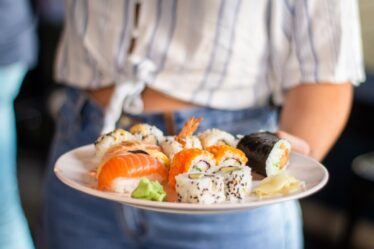
When selecting meat for burgers, ground beef is the most common choice. The best cuts for ground beef burgers are chuck, sirloin, or a combination of both. Chuck provides rich flavor and ideal fat content, while sirloin offers a leaner texture.
An 80/20 meat-to-fat ratio is recommended for juicy, flavorful burgers. Alternative options include ground pork, lamb, turkey, or meat blends, each requiring appropriate seasoning adjustments. Meat quality is crucial for superior burgers.
Grass-fed beef is preferred for its richer flavor and sustainability. Purchasing from local butchers or farms can ensure higher quality and freshness. Selecting the appropriate meat is fundamental to creating delicious burgers that will satisfy diners.
Key Takeaways
- Choose high-quality ground meat with a good fat content for juicy and flavorful burgers
- Season the meat generously with salt and pepper, and add other flavorings like Worcestershire sauce or garlic powder
- Gently form the patties, making an indentation in the center to prevent bulging during cooking
- Preheat the grill and clean the grates to prevent sticking and ensure even cooking
- Grill the patties over direct heat, flipping only once, and let them rest before assembling the perfect burger
Seasoning and Flavoring
Classic Seasonings
A good quality cut of meat will already have plenty of flavor on its own, but adding the right seasonings can make all the difference. A classic burger seasoning typically includes salt, pepper, garlic powder, and onion powder.
Getting Creative with Seasonings
Don’t be afraid to think outside the box and get creative with your seasonings. Consider adding ingredients like Worcestershire sauce, soy sauce, smoked paprika, or even a dash of hot sauce to give your burgers an extra kick.
Incorporating Flavorings
In addition to seasonings, consider incorporating flavorings into your burger patties. This could include mixing in ingredients like minced garlic, finely chopped onions, fresh herbs, or even grated cheese. These additions not only add depth of flavor to your burgers but also help keep them moist and juicy during the grilling process. Just be mindful not to overwork the meat when mixing in these flavorings, as this can result in tough and dense patties.
By carefully selecting your seasonings and flavorings, you can create a burger that is bursting with delicious flavors and aromas that will have everyone asking for your secret recipe.
Forming the Patties
Forming the perfect burger patties may seem like a simple task, but there are a few key tips to keep in mind to ensure that they turn out just right. Start by dividing your ground meat into evenly sized portions, typically around 6-8 ounces each. Gently shape each portion into a ball without compacting the meat too much.
Then, using your hands or a burger press, gently flatten each ball into a patty that is about 1 inch thick. It’s important not to overwork the meat during this process, as this can result in tough and dry burgers. Another important consideration when forming burger patties is to create an indentation in the center of each patty with your thumb.
This will help prevent the patties from puffing up in the middle as they cook, ensuring that they remain flat and even. Additionally, make sure that the edges of the patties are slightly thicker than the center to account for any shrinkage during cooking. By following these simple steps, you can create perfectly shaped burger patties that will cook evenly and result in a deliciously juicy burger.
Preparing the Grill
| Grill Preparation Steps | Time Taken (minutes) |
|---|---|
| Cleaning the grill | 10 |
| Preheating the grill | 15 |
| Checking gas/propane levels | 5 |
| Checking charcoal supply | 5 |
Before you start grilling your burger patties, it’s essential to properly prepare your grill to ensure that they cook evenly and develop a delicious charred exterior. Start by cleaning the grill grates thoroughly with a wire brush to remove any leftover residue from previous grilling sessions. Then, preheat the grill to medium-high heat, around 375-400°F.
This will help create a nice sear on the outside of the patties while ensuring that they cook through evenly. If you’re using a charcoal grill, make sure to spread the hot coals evenly across the bottom of the grill to create an even cooking surface. For gas grills, preheat all burners on high for 10-15 minutes before reducing the heat to medium-high.
Additionally, consider oiling the grill grates lightly with a high smoke point oil like canola or vegetable oil to prevent the patties from sticking. By taking the time to properly prepare your grill, you’ll set yourself up for success when it comes time to cook your burger patties.
Grilling the Patties
Once your grill is preheated and ready to go, it’s time to start grilling your burger patties. Place the patties on the grill grates and close the lid to allow them to cook undisturbed for 3-4 minutes. This will help develop a nice sear on the bottom of the patties while locking in their juices.
Avoid pressing down on the patties with a spatula while they cook, as this can cause the juices to escape and result in dry burgers. After 3-4 minutes, carefully flip the patties using a spatula and continue cooking for an additional 3-4 minutes with the lid closed. If you’re adding cheese to your burgers, place a slice on top of each patty during the last minute of cooking and close the lid to allow it to melt.
Keep in mind that cooking times may vary depending on the thickness of your patties and the heat of your grill, so it’s essential to keep an eye on them to prevent overcooking. By following these simple grilling techniques, you can achieve perfectly cooked burger patties with a delicious charred exterior and juicy interior.
Checking for Doneness

Using an Instant-Read Meat Thermometer
The most reliable method to determine if your burger patties are cooked is by using an instant-read meat thermometer. Simply insert the thermometer into the thickest part of each patty, and if it reads 160°F, your burgers are ready to be taken off the grill.
Visual Cues for Doneness
If you don’t have a meat thermometer, you can also use visual cues to check for doneness. Cut into one of the patties slightly to check if it’s reached your desired level of doneness. Remember, ground beef should be cooked to at least 160°F to ensure that any harmful bacteria are killed off.
Resting and Assembling Your Burgers
Once you’ve determined that your burger patties are done, remove them from the grill and allow them to rest for a few minutes before assembling your burgers. This will help redistribute the juices throughout the patties, resulting in a more flavorful and juicy burger.
Assembling the Perfect Burger
Assembling the perfect burger is where all your hard work comes together into a delicious and satisfying meal. Start by selecting high-quality burger buns that will hold up well against the juicy patties and flavorful toppings. Toasting the buns lightly on the grill adds an extra layer of flavor and helps prevent them from becoming soggy.
Next, consider adding a variety of toppings and condiments to customize your burgers to your liking. Classic options include lettuce, tomato, onion, pickles, ketchup, mustard, and mayonnaise. However, feel free to get creative with your toppings by adding ingredients like caramelized onions, sautéed mushrooms, avocado slices, or even a fried egg.
When assembling your burgers, consider layering the ingredients strategically to ensure that each bite is packed with flavor and texture. Start with a generous spread of condiments on both sides of the bun to prevent it from becoming soggy. Then add lettuce and tomato slices followed by the burger patty and any additional toppings you desire.
By following these steps and paying attention to detail when assembling your burgers, you can create a masterpiece that is not only visually appealing but also bursting with delicious flavors and textures. Whether you’re hosting a backyard barbecue or simply craving a homemade burger, these tips will help you create an unforgettable dining experience for yourself and your guests.
If you’re looking for a delicious side dish to pair with your grilled hamburgers, check out this article on Armenian Cucumber: More Than Just a Salad Ingredient. This versatile vegetable can be used in a variety of dishes, from salads to soups, and its refreshing flavor makes it the perfect accompaniment to a juicy burger. Learn more about the culinary possibilities of Armenian Cucumber here.
FAQs
What temperature should the grill be for cooking hamburgers?
The grill should be preheated to medium-high heat, around 375-400°F (190-200°C), before cooking hamburgers.
How long should you cook hamburgers on a grill?
Hamburgers should be cooked for about 4-5 minutes per side for medium-rare, 5-6 minutes per side for medium, and 6-7 minutes per side for well-done.
How do you know when hamburgers are done on the grill?
Hamburgers are done when they reach an internal temperature of 160°F (71°C) for beef and 165°F (74°C) for poultry. You can use a meat thermometer to check the temperature.
Should you flip the hamburgers on the grill?
It is recommended to flip the hamburgers only once during cooking to ensure even cooking and to prevent them from falling apart.
Do you need to oil the grill before cooking hamburgers?
It is a good idea to lightly oil the grill grates before cooking hamburgers to prevent sticking and to help achieve those classic grill marks.



